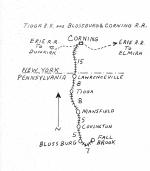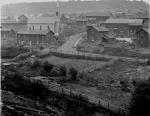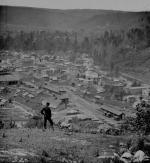![header=[Marker Text] body=[One of the early railroads in the Northeast was completed in 1840 from Corning, N.Y., to Blossburg. It was built by the Tioga Navigation Company to connect the Chemung Canal, and the Erie Railroad, with the local coal fields.] sign](http://explorepahistory.com/kora/files/1/10/1-A-2C4-139-ExplorePAHistory-a0k3h7-a_450.jpg)
Mouse over for marker text
Name:
Corning and Blossburg Railroad [Bituminous Coal]
Region:
Allegheny National Forest Region
County:
Tioga
Marker Location:
S. Main St. (Business U.S. 15), Mansfield
Dedication Date:
June 4, 1983
Behind the Marker
Railroads were critical to the opening of Pennsylvania's bituminous coal fields. During the eighteenth and early nineteenth centuries, most of the coal fields were isolated, limiting sales of coal primarily to local areas. From the 1820s to 1840s entrepreneurs pursued construction of canals and slack-water dams to facilitate the shipment of coal down-river to larger markets. Beginning in the 1840s they turned to railroads to connect mines to markets. The construction of the Corning and Blossburg Railroad from Blossburg, Tioga County, to Corning, New York, was a case in point.
The first coal discovery in Tioga County came in 1792. About 1815 David Clemons made the first shipment of coal, by wagon, from Blossburg down the Tioga River valley to southern New York. The southern counties of New York beckoned as markets for coal. These counties faced a growing shortage of wood for fuel. Aware of this need for fuel, entrepreneurs pressed the Pennsylvania legislature to charter the Tioga Navigation Company in 1826 to construct a canal from Blossburg north to the New York state line. The company, however, failed to build the canal. Instead, it constructed a railroad.
coal discovery in Tioga County came in 1792. About 1815 David Clemons made the first shipment of coal, by wagon, from Blossburg down the Tioga River valley to southern New York. The southern counties of New York beckoned as markets for coal. These counties faced a growing shortage of wood for fuel. Aware of this need for fuel, entrepreneurs pressed the Pennsylvania legislature to charter the Tioga Navigation Company in 1826 to construct a canal from Blossburg north to the New York state line. The company, however, failed to build the canal. Instead, it constructed a railroad.
The New York state legislature, also aware of the southern tier's need, chartered a railroad line from present-day Corning to the Blossburg railroad at Lawrenceville. The New York legislature also wanted Tioga County coal to go beyond Corning and to connect Corning to wide markets. To this end, it authorized construction of the Chemung Canal, completed in 1833 to link Corning with Syracuse and the Erie Canal. The completion of the railroad line from Blossburg to Corning in 1840 permitted the shipment of 4,325 tons of coal to New York. The next year the railroad transported almost 26,000 tons.
Entrepreneurs improved transportation in other regions of the bituminous coal fields to sell coal to wider markets. Before 1840 the Monongahela River valley was the only region that shipped significant amounts outside the local area. From the late 1810s to the 1830s, fleets of coal boats floated down the Monongahela and Ohio rivers. However, floods, drought, and freeze ups in winter stopped shipments, sometimes for months, or wrecked the boats.
In 1837 construction of slack-water dams and locks began on the Monongahela River between Brownsville and Pittsburgh. The dams impounded water upstream, deepening the navigation channel and helping to regulate the flow of water. After construction was completed in 1844, new mines opened in the Monongahela River valley and coal shipments rose. A similar series of locks and dams were completed on the Youghiogheny River in 1850.
Railroads became the key link to larger markets, particularly eastern markets, for most of Pennsylvania's bituminous coal mines. In 1846 the state legislature chartered the Pennsylvania Railroad Company to build a railroad line from Harrisburg to Pittsburgh, in part to carry bituminous coal east. This main line began operation in 1854. The Westmoreland Coal Company of Philadelphia, one of the earliest and largest bituminous mining companies in Pennsylvania, soon sought lower transportation rates from the Pennsylvania Railroad to haul its bituminous coal from mines in western Pennsylvania to Philadelphia and New York, where gas works burned coal to make coal gas used for illumination.
In 1855, William Larimer, Jr., one of the coal company's owners, told the directors of the Pennsylvania Railroad, "If you will grant us a freight rate that will permit us to enter into a contract with the city gas works to supply it with coal your company will enjoy the benefits of earning on that tonnage and we shall be able to reap benefits for our miners and our shareholders. All of us would be benefited and none injured in the slightest degree. Other sales would assuredly follow." The railroad company reduced its rates, and the Westmoreland Coal Company began the first deliveries of coal to eastern markets by railroad.
The arrival of the Pennsylvania Railroad in Pittsburgh marked the beginning of a railroad-building boom across much of Pennsylvania. The Pennsylvania Railroad and other railroads opened the bituminous coal fields of Pennsylvania to wide markets by the late nineteenth century. Two short-line railroads linked the isolated Broad Top Field, located in Bedford, Fulton, and Huntingdon Counties, to eastern markets. In 1856 the Huntingdon and Broad Top Railroad was completed through the western part of the field, connecting at Huntingdon with the Pennsylvania Railroad's main line between Harrisburg and Pittsburgh.
Shortly after the Huntingdon and Broad Top Railroad started shipping coal, a Huntingdon paper reported, "there is no end to the demand for Broad Top coal. Although hundreds of tons are brought in daily, yet the demand is greater than can be supplied." The East Broad Top Railroad also constructed a line northward through Huntingdon County in 1872-1873 to link with the Pennsylvania Railroad main line at Mount Union.
Railroad lines were crucial to bituminous competition with Pennsylvania's anthracite mines for eastern markets. Railroad shipments helped bituminous mines surpass anthracite mines in production in 1897. Railroads also proved critical to marketing anthracite coal. During the 1840s large railroad companies constructed trunk lines into the anthracite fields and became the dominant anthracite carriers. These anthracite railroad companies played a much different role in the anthracite fields than railroads did in the bituminous fields.
Although railroads acquired some mines in the bituminous fields, anthracite railroads bought up thousands of acres of anthracite coal lands. By the 1860s, powerful anthracite railroad companies dominated not only shipping, but also anthracite production. Their concentration of ownership and control was a strong contrast to the decentralized ownership of bituminous mines in western Pennsylvania.
The first
The New York state legislature, also aware of the southern tier's need, chartered a railroad line from present-day Corning to the Blossburg railroad at Lawrenceville. The New York legislature also wanted Tioga County coal to go beyond Corning and to connect Corning to wide markets. To this end, it authorized construction of the Chemung Canal, completed in 1833 to link Corning with Syracuse and the Erie Canal. The completion of the railroad line from Blossburg to Corning in 1840 permitted the shipment of 4,325 tons of coal to New York. The next year the railroad transported almost 26,000 tons.
Entrepreneurs improved transportation in other regions of the bituminous coal fields to sell coal to wider markets. Before 1840 the Monongahela River valley was the only region that shipped significant amounts outside the local area. From the late 1810s to the 1830s, fleets of coal boats floated down the Monongahela and Ohio rivers. However, floods, drought, and freeze ups in winter stopped shipments, sometimes for months, or wrecked the boats.
In 1837 construction of slack-water dams and locks began on the Monongahela River between Brownsville and Pittsburgh. The dams impounded water upstream, deepening the navigation channel and helping to regulate the flow of water. After construction was completed in 1844, new mines opened in the Monongahela River valley and coal shipments rose. A similar series of locks and dams were completed on the Youghiogheny River in 1850.
Railroads became the key link to larger markets, particularly eastern markets, for most of Pennsylvania's bituminous coal mines. In 1846 the state legislature chartered the Pennsylvania Railroad Company to build a railroad line from Harrisburg to Pittsburgh, in part to carry bituminous coal east. This main line began operation in 1854. The Westmoreland Coal Company of Philadelphia, one of the earliest and largest bituminous mining companies in Pennsylvania, soon sought lower transportation rates from the Pennsylvania Railroad to haul its bituminous coal from mines in western Pennsylvania to Philadelphia and New York, where gas works burned coal to make coal gas used for illumination.
In 1855, William Larimer, Jr., one of the coal company's owners, told the directors of the Pennsylvania Railroad, "If you will grant us a freight rate that will permit us to enter into a contract with the city gas works to supply it with coal your company will enjoy the benefits of earning on that tonnage and we shall be able to reap benefits for our miners and our shareholders. All of us would be benefited and none injured in the slightest degree. Other sales would assuredly follow." The railroad company reduced its rates, and the Westmoreland Coal Company began the first deliveries of coal to eastern markets by railroad.
The arrival of the Pennsylvania Railroad in Pittsburgh marked the beginning of a railroad-building boom across much of Pennsylvania. The Pennsylvania Railroad and other railroads opened the bituminous coal fields of Pennsylvania to wide markets by the late nineteenth century. Two short-line railroads linked the isolated Broad Top Field, located in Bedford, Fulton, and Huntingdon Counties, to eastern markets. In 1856 the Huntingdon and Broad Top Railroad was completed through the western part of the field, connecting at Huntingdon with the Pennsylvania Railroad's main line between Harrisburg and Pittsburgh.
Shortly after the Huntingdon and Broad Top Railroad started shipping coal, a Huntingdon paper reported, "there is no end to the demand for Broad Top coal. Although hundreds of tons are brought in daily, yet the demand is greater than can be supplied." The East Broad Top Railroad also constructed a line northward through Huntingdon County in 1872-1873 to link with the Pennsylvania Railroad main line at Mount Union.
Railroad lines were crucial to bituminous competition with Pennsylvania's anthracite mines for eastern markets. Railroad shipments helped bituminous mines surpass anthracite mines in production in 1897. Railroads also proved critical to marketing anthracite coal. During the 1840s large railroad companies constructed trunk lines into the anthracite fields and became the dominant anthracite carriers. These anthracite railroad companies played a much different role in the anthracite fields than railroads did in the bituminous fields.
Although railroads acquired some mines in the bituminous fields, anthracite railroads bought up thousands of acres of anthracite coal lands. By the 1860s, powerful anthracite railroad companies dominated not only shipping, but also anthracite production. Their concentration of ownership and control was a strong contrast to the decentralized ownership of bituminous mines in western Pennsylvania.










